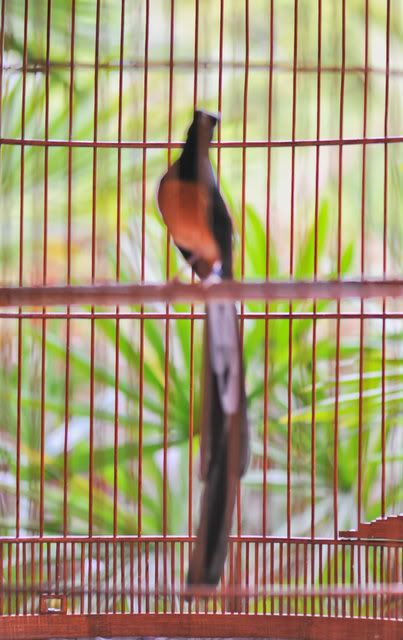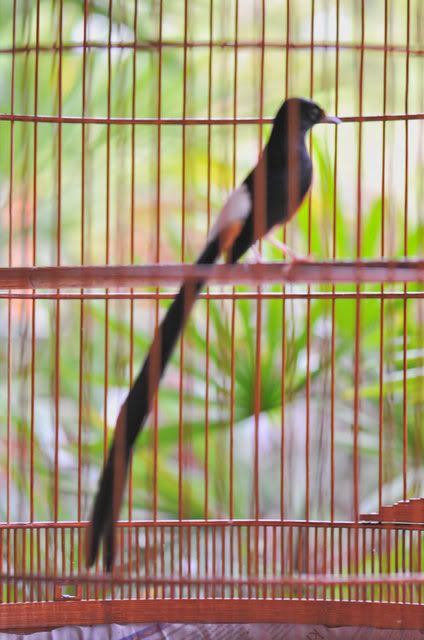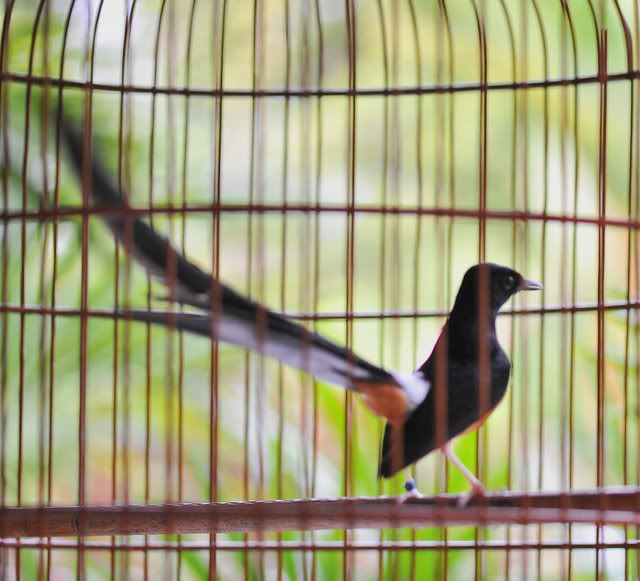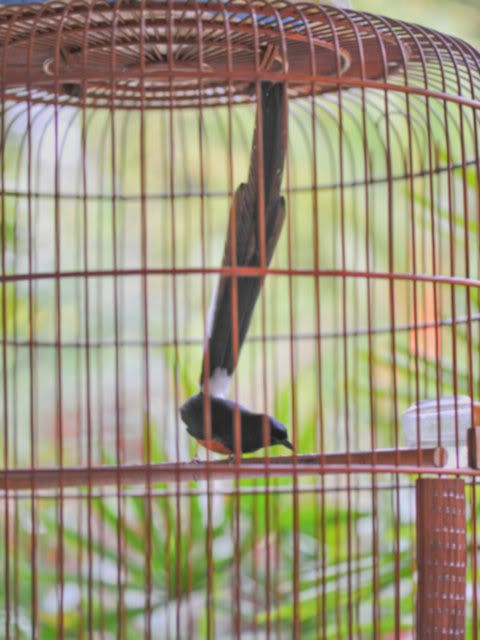Actually, neither Jeff nor I expected him to perform as he had only recently completed his molt and appeared to have no form as yet. This was evident from the pale insides of his beak.
As experienced shama keepers know, the inside beak will turn a very dark red to almost black when a bird is in form. The paler the inside beak the lesser the form. The pale beak indicates that the bird does not have the hormone, testosterone, which is necessary for the bird to sing and display well in the presence of other male shamas.
DDS207 surprised us both with his performance. At least he surprised me.
I will mention shortly about DDS207's performance. First, I would like to say something about Jeff's choice of him. When DDS207 was a juvenile, I had tried to dissuade Jeff from selecting him and to take one of my other young birds. Amongst others, I offered DDS206 and DDS225. I wanted to make sure that Jeff would not be disappointed with his shama from me.
It wasn’t that I thought DDS207 was not worth keeping. Far from it. I could see that he had a strong character, excellent display and very good structure. In fact, he seemed to have all the makings of a potential champion. Even when an aggressive Super Model was placed close to him, he had not been cowed.
My only reservation was that he had the shortest tails of any juvenile I had ever bred – 4½”. This is really short and I feared that the length of his adult tails might mirror his juvenile tails. While it was possible that his adult tails would be long I wished to be sure for Jeff's sake.
I knew of course that my shamas have long-tailed genes in them and even short juvenile tails do not necessarily mean that the adult tails would be short.
Super Model, for instance, had juvenile tails of only 4¾” but his adult tails, after the third molt, were over 12”. Nevertheless, knowing the amount of effort that needs to go into caring for a shama from juvenile to adulthood, I did not want Jeff to risk being disappointed.
Jeff had insisted on choosing DDS207. He acknowledged that its adult tails might not be as long as my other birds but he said that he was so impressed with DDS207’s other attributes that he was prepared to take a chance. He also said that even if DDS207's tails turned out to be short, he would not regret his choice.
Well, I am relieved that DDS207’s tails have not disappointed. I would estimate them at presently about 11” after his molt from juvenile. They are soft and curved as you can see from the photograph below:

The photographs are badly taken as I was taking the photos quickly and had difficulty focusing on the bird through the bars of the cage. Nevertheless, I think the character and beauty of the bird shines through.

This was DDS207’s first trip in a vehicle. As is usual for birds that are not used to travel, when his cage cover was removed, his beak was slightly agape in stress. However, almost immediately, he straightened his body and burst into song when he heard my birds. Jeff looked at me and I smiled my surprise and appreciation.

I then took out some of my young birds and DDS207 began to also display. He would lift his tails about 60 degrees and wave them in the air 3 to 4 times before lowering them while “playing the perch”. Jeffrey smiled happily like a proud father seeing his son do well in his first outing in sporting competition. I was happy for him.
After awhile, we decided to test the strength of DDS207's character by placing a seasoned in-form adult next to him. The only adult shama I had in a cage was a Medan type bird that had won several competitions in Indonesia and which is in good form. I had acquired him to be a tutor to my birds. I placed him next to DDS207 and he sang and displayed. DDS207 was not intimidated by the older bird and displayed and sang even more vigorously. This shows aggression and was impressive against an older in-form shama. He also aggressively dived to the cage floor every now and then as in the photo below:

He then had another surprise for us as he began to "play snake-head". For those who do not know what this means, an aggressive male shama may nod its head up and down, like a cobra does, when there is aother aggressive male shama close to it. Not all male shamas in top form exhibit this characteristic. It is beautiful to watch.
DDS207 continued to sing and display throughout the 2 hours or so that Jeff was at my home.

For a bird with as yet no form, his performance was extraordinary and shows the strong character that Jeff had seen in him when he was a juvenile. I can’t wait to see his full performance when he is in top form. I am glad that Jeff seems to have got the bird of his dreams.
No comments:
Post a Comment